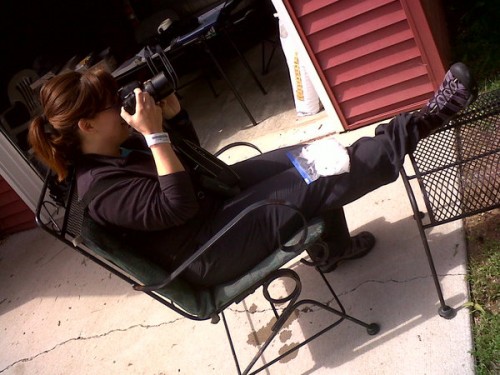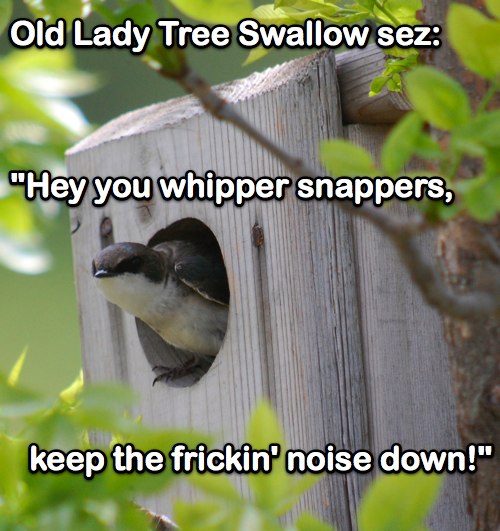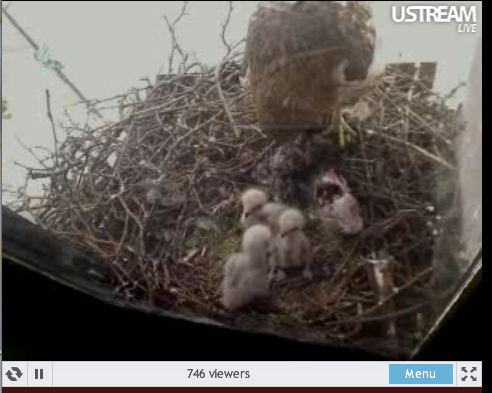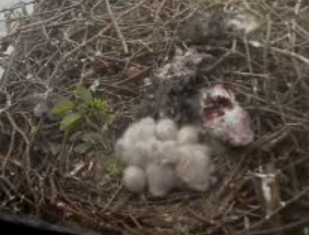Ah, Saturday started out so promising! We had spring bird banding planned at Mr. Neil's, I found out that my nephew has an exhibit at the Louvre (yeah, baby, that Louvre and it's part of an app that's really cool called Augmented Reality Wallpaper), Non Birding Bill was frying up some maple bacon to get the banding started off right--it was all so innocent then. We had the usual Minnesota back hand weather-wise. A snow free March and April meant that the first weekend in May was going to be cold, cloudy and involve snow and sleet. Because of the wet and an mud on the trails, I put on a pair of spare Wellingtons at the house--the boots were a couple sizes too big but I compensated with really thick socks. However, at one point during a net check, my foot went one way, my right knee the other which was followed by my collapse and intense pain. It felt very similar to when I dislocated my knee as a teenager. But I was able to stand up and limp--which I was not able to do when I dislocated my knee.

NBB drove me to Urgent Care where ironically I was banded, weighed and measured (and had a few unpleasant things done to my knee). NBB said, "Ha! Now you know what it's like for the birds when you band them." They made a note of higher blood pressure and assured me that was normal for a painful knee injury. The spike in pressure wasn't about the pain but more like, "Holy Crap, I fly to Utah on Thursday for the Great Salt Lake Bird Festival on top of how much I love gallavanting in the woods for warblers in spring on top of my national park service duties. I can't be injured now!"

Fortunately, it appears to only be a sprain and not too severe of an injury and I'm supposed to stay off it and ice it for as long as possible. NBB is doing a great job of forcing me to take it easy. I was actually back to the banding in about an hour and didn't miss too much. Lorraine got the above photo of me taking photos of Amber and Roger removing a rose-breasted grosbeak and downy woodpecker from the nets.

Here is a none too pleased rose-breasted grosbeak.
The great thing about the modern age is that I put in a call to my hotel in Utah securing a ground floor room, made arrangements to get some mobility assistance in the airport and gave the festival a heads up to my limited mobility. But on the upside, I'm doing a digiscoping workshop, Birds and Beers and I'm Friday night's guest speaker--all of those aren't too strenuous.
I'm excited about speaking. The festival keynote had to step down at the last minute for health reasons, so Bill Fennimore who was Friday's speaker is filling in for her on Saturday and I'm filling in for him on Friday night. I'm going to do my Kazakhstan Program: An Adventure in Birds and Bathrooms. Utah is one of my favorite birding states, I'm so grateful that my injury may slow me down but not stop me from enjoying this beautiful area.
In the meantime, this business of being forced to sit in one spot for several hours will be a good opportunity to type up some birding app reviews and a book review. I'm reading an AMAZING feather book--best bird book to come out this year.

 After doing a bit of birding this spring, I was heading home when what looked like a distant sandhill crane caught my attention. I pulled over to the side of the road and grabbed my Swarovskis...only to find a wood tick waiting for me right on the eye cup...ewwww! Ticks, the down side of the outdoors.
After doing a bit of birding this spring, I was heading home when what looked like a distant sandhill crane caught my attention. I pulled over to the side of the road and grabbed my Swarovskis...only to find a wood tick waiting for me right on the eye cup...ewwww! Ticks, the down side of the outdoors.










 We had a small flock of rose-breasted grosbeaks arrive yesterday. They are loading up on food until the insects are out. Just the males are here now, with the cold and the wind, they weren't singing too loud today but I'm sure they will set up terretories soon and if they squabbling at the feeders is to be believed, they'll be duking it out for the best nesting tree too.
We had a small flock of rose-breasted grosbeaks arrive yesterday. They are loading up on food until the insects are out. Just the males are here now, with the cold and the wind, they weren't singing too loud today but I'm sure they will set up terretories soon and if they squabbling at the feeders is to be believed, they'll be duking it out for the best nesting tree too.


 I saw some Canada goose goslings yesterday as well as a few mallard ducklings. Another serious spring sign was hearing an oriole sing--do you have your
I saw some Canada goose goslings yesterday as well as a few mallard ducklings. Another serious spring sign was hearing an oriole sing--do you have your 













